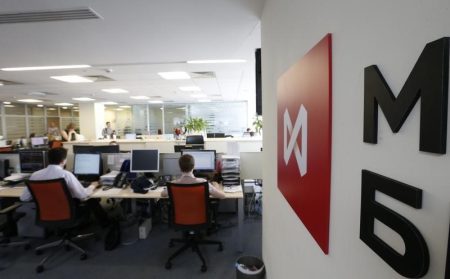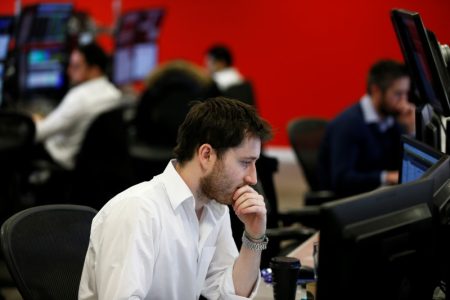By Naomi Rovnick and Rae Wee
LONDON, SINGAPORE (Reuters) – Global stocks were set to end a roller-coaster week in the red as investor anxiety about U.S. growth combined with downbeat earnings weighing on tech stocks, while gold, government bonds and currencies seen as safe havens gained.
In a selloff that started in Asia and sent share index down 5.8% in a loss not seen since the March 2020 COVID-19 crisis, MSCI’s broad gauge of global stocks dropped 0.8%.
Europe’s main Stoxx share index was 1.6% lower in early dealings as all of the region’s main equity gauges fell and futures trading implied Wall Street’s would open more than 1% lower later in the day.
The market mood soured after weaker-than-expected U.S. factory data on Thursday sparked fears the U.S. Federal Reserve may have harmed the economy by holding benchmark borrowing costs at a 23-year high of 5.25%-5.5% for a year.
European technology stocks also fell to their lowest level in over six months on Friday as investors dumped semiconductor stocks following disappointing earnings from Intel (NASDAQ:).
The STOXX Europe 600 technology index was last down 3.6% to its lowest since January.
Futures trading implied that the tech-heavy U.S. share index would start the New York session 1.7% lower.
Investors see the world’s major central banks starting to shift their focus away from inflation and towards supporting economies and jobs markets that may now be taking the full force of monetary tightening campaigns that began in late 2021.
Ahead of the keenly watched U.S. non-farm payrolls report later in the day, money markets on Friday priced a 31% probability the Fed will cut rates by 50 basis points (bps) next month.
Economists expect U.S. employers added 175,000 new hires in July, down from 206,000 a month earlier.
“The historical experience is that turnarounds in the labor market can occur quickly and brutally and that relatively moderate increases in unemployment have been enough to trigger recessions in the United States,” SEB US economist Elisabet Kopelman said.
The dropped 3 bps to 3.978% on Friday as investors poured into the safe-haven bonds.
The two-year yield, which typically reflects near-term interest rate expectations, touched its lowest since May 2023 before bouncing slightly higher to 4.14%. Bond yields move inversely to prices.
The 10-year German bund yield, a benchmark for euro zone debt costs, fell 3bps to 2.248%.
“The market has gone to pricing in three Fed cuts by year end, and while that does feel like we have jumped the gun, investors will wait for today’s payrolls to confirm or deny this. We will also be watching for a rise in the employment rate which will give us clues about a weaker labour market and as a potential recessionary signal,” Fidelity International fixed income manager Shamil Gohil said.
In currency markets, the yen added 0.3% to 149 per dollar as haven buying fuelled a recovery for the weakened Japanese currency buoyed up by the Bank of Japan’s move on Wednesday to lift interest rates to levels unseen in 15 years.
The Swiss franc rose to its strongest level since early February to 0.87145 per dollar in Asian trading, before edging lower in the European morning.
Sterling was on track for a 1.1% weekly drop against the dollar as traders speculated that the Bank of England would follow its first rate cut of this cycle on Thursday with another in November.
Commodity markets broadly displayed global growth fears as gold added 0.6% to $2,462 an ounce and , although up on the day at $80.28 a barrel, headed for a fourth successive weekly loss.
Read the full article here











